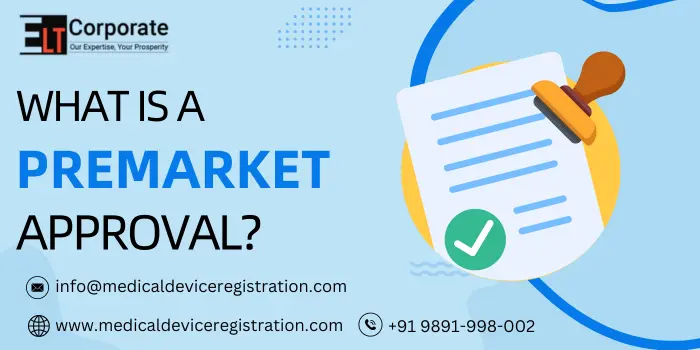The FDA, also known as the Food and Drug Administration, uses Premarket Approval to ensure that class III MDRs are effective or safe for users. Indeed, this Approval is not needed for MDR second – and third-class devices. Premarket Approval is a rigorous approval process. Look below, as all details about premarket Approval of medical devices are mentioned there.
PMA Process
The PMA (Premarket Approval) process is a regulatory procedure utilized by the U.S. Food and Drug Administration (FDA) to evaluate and approve specific medical devices before they can be sold. This cycle is expected for clinical gadgets that are considered high-risk, such as life-sustaining devices.
Application Submission – The medical device manufacturer must submit a PMA application to the FDA. This application must incorporate detailed data about the device, such as its plan, manufacturing processes, and how it will be utilized.
Review Process – The FDA reviews the application to ensure the device is safe and powerful for its expected use. This review includes an evaluation of preliminary clinical information showing that the device works and is safe.
Inspections – The FDA may also inspect the manufacturing facility to ensure it meets specific quality standards.
FDA Decision – After reviewing all the information and data, the FDA will decide whether to approve the device for sale or not. Whenever supported, the device can be promoted.
Post-Approval Monitoring – Even after a gadget is supported, the FDA keeps checking its presentation to guarantee its safety.
Elements Of PMA Application
The elements of a Premarket Approval (PMA) application, which is a regulatory process in the United States managed by the Food and Drug Administration (FDA), include the following key components:
- Cover Letter and Application Form
- Executive Summary
- Device Description
- Nonclinical Laboratory Studies
- Clinical Data
- Product Labelling
- Environmental Impact Consideration
- Financial Certification or Disclosure Statement
Different Premarket Approval Application Options
There are four types of PMA application options, and below here, all the Premarket Approval options are mentioned:-
- Traditional PMA
- Modular PMA
- Humanitarian Device Exemption
- Product Development Protocol
Traditional PMA
Traditional PMA is the most well-known technique for presenting a Premarket Approval (PMA) application to the FDA for Class III medical devices. It involves presenting a total application in a single package that incorporates numerous volumes of material, such as device description and intended use, nonclinical and clinical studies, case report forms, manufacturing methods, and labeling.
Modular Premarket Approval
A Modular Premarket Application (PMA) is a strategy for submitting a PMA to the FDA in sections or modules. The FDA works with manufacturers to develop a customized PMA “shell” that outlines the plan for modular submissions, including timelines of contents and items for every module.
Product Development Protocol (PDP)
A product development protocol (PDP) is a contract between a manufacturer and the FDA outlining a medical device’s design and development activities, results, and acceptance criteria for its outputs. The PDP process is a premarket approval (PMA) application technique that combines clinical evaluation and information development for marketing approval.
Humanitarian Device Exemption
A Humanitarian Device Exemption (HDE) is a marketing application for a medical device that the U.S. Food and Drug Administration (FDA) has approved to be marketed without evidence of effectiveness. The FDA refers to these gadgets as “Humanitarian Use Devices” (HUDs). HUDs treat or diagnose diseases or conditions that affect fewer than 8,000 people in the U.S. annually. The FDA grants an HDE to devices that fall under this class.
Also Check these Latest Articles:-
What Is The Difference Between 510(K) And PMA?
A 510(k) and premarket approval (PMA) are both submissions to the FDA for medical devices. A 510(k) is needed for medium-risk devices, while a PMA is required for high-risk or novel devices.
What Goes Into A PMA?
Premarket Approval (PMA) is the application for medical devices that should include these sections:-
Nonclinical laboratory studies: Results of nonclinical studies, for example, microbiological, toxicological, immunological, biocompatibility, stress, wear, and shelf life tests
Clinical investigations: Clinical trial results involve human patients
Device description: Description of the device, including its components, properties, ingredients, and operating principles
Manufacturing and processing: Manufacturing and processing of device statements
Safety and effectiveness data: Reports of all known information about the device’s safety and effectiveness and a summary of that information
Professional and patient labelling: Patient labelling & proposed professional
What’sWhat’s Required In A PMA Submission?
Here are the items required for Premarket Approval Submission:-
- Device Description consists of operating principles, Components, Ingredients, and Properties.
- Manufacturing & Process – Detailed description for the public to help them understand it easily.
- General Information – Name of the applicant, Content Table, and Application page Summary in 11 to 15 pages.
- Effective & Safety Data – Information reports, clinical data reports, and Clinical Studies reports.
- Documentation – Journal Entries, labels, samples, financial statements, and certifications.
How Long Does the PMA Process Take?
The Premarket Approval Process probably takes “9 to 36 months“.
What is PMA in Pharmacy?
Premarket Approval in Pharmacy is the process under the Food and Drug Association (FDA) to review medical devices. This process checks whether the medical device is safe. For more refined details, please directly visit the medicaldeviceregistration.com.
What is the Complete Form of PMA?
Premarket Approval is the complete form of a term called “PMA.”


